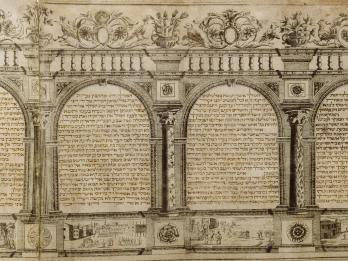Sefer ḥayim ve- ḥesed (Book of Life and Righteousness): On Purim
Aryeh Leyb ben Daniel
Francesco Griselini
Ḥayim Abulafia
1736
Enactments made by the wondrous rabbi; may the Almighty guard him and preserve him in life!
Their custom on the night of Purim was for each individual to pray in his own private domain and home, and, in order to obtain a minyan [quorum for prayer], they would struggle to assemble young lads and minors; and they would kindle a small lamp to enable them to read the Megilah [scroll of Esther], and a minor with no appreciation of the correct articulation of the words would come forward to act as communal prayer leader to read the Megilah, and no minyan could be found in the various synagogues of the community—they would sit in the dark and kindle a small lamp in order to read the Megilah, thereby transgressing the enactment of the Great Assembly who interpreted the words “every family” [from the book of Esther] as to include the priestly and Levitical families who were to abandon their service [in the Temple] and come to hear the Megilah being read; and indeed the members of Rabbi’s [Judah the Prince] household relied on this for their practice of canceling their Torah study and coming to hear the reading of the Megilah. And some of the great authorities have written that in a city that has many synagogues, they should all assemble in one synagogue and read [the Megilah] all together, so as to publicize the miracle—and I decreed that, at least, the members of a synagogue should not pray in houses and private spaces on the night of Purim and by day, pursuant to their custom, but that they should all come to the synagogue and kindle lights and recite liturgical hymns until an hour-and-a-quarter after sunset, when it is definitely night, and then recite arvit [the evening prayer]—for if were they to read the Megilah during the day, the blessings recited over the Megilah would be uttered in vain, and one would not fulfill the obligation of reading the Megilah [in which it is written]: And they accepted upon themselves [see Esther 9:27, to observe the fourteenth of Adar as Purim]—and that they should continue with their fasting until the time for the Megilah reading, and read it in intense publicity and with numerous lights shining, like on a holiday evening, and they should wear festive apparel before coming to the synagogue. Happy is the nation that adopts such practices!
Other works by Abulafia: ‘Ets ha-ḥayim (1729); Mikra’e kodesh (1729); Yashresh Ya‘akov (1729); Yosef lekaḥ (1730).
Credits
Published in: The Posen Library of Jewish Culture and Civilization, vol. 5.




![9. [Image: 013 Hanukkah lamp, Morocco, 18th century]. Hanukkah Lamp Oil lamp with cut-outs in various shapes, with row of eight cups on bottom and one cup on top.](/sites/default/files/styles/embedded_image_sm_1x/public/images/vol05/Posen5_blackandwhite129_color.jpg?itok=3afKuYtU)

